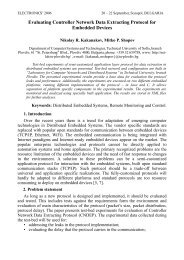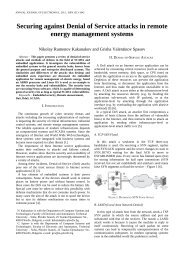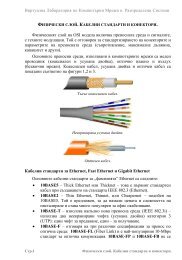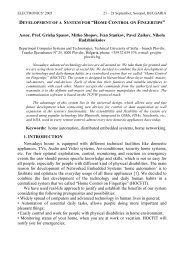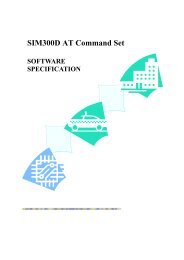CGI-based applications for distributed embedded systems for ...
CGI-based applications for distributed embedded systems for ...
CGI-based applications for distributed embedded systems for ...
Create successful ePaper yourself
Turn your PDF publications into a flip-book with our unique Google optimized e-Paper software.
International Conference on Computer Systems and Technologies - CompSysTech’2004<br />
Web-<strong>based</strong>, Internet-integrated <strong>embedded</strong> <strong>systems</strong><br />
The BECK’s microcontroller IPC@CHIP SC12 is a new generation system-on-chip<br />
that has its own <strong>embedded</strong> hardware and software means <strong>for</strong> integrating into computer<br />
networks, <strong>based</strong> on TCP/IP communication [4].<br />
The IPC@CHIP is a combination of hardware and software. The software is preinstalled<br />
and consists of a Real Time Operating System (RTOS) with file system, complete<br />
TCP/IP stack, PPP Server and client, web server, FTP server, Telnet Server and<br />
Hardware interface layer.<br />
With this strategy, much of the required functionality is part of the operating system.<br />
Only the essential application specific functionality is implemented as a 16 Bit DOS<br />
application that is transferred to the file system per FTP.<br />
The hardware consists of a 16 bit 186 CPU, RAM, Flash, Ethernet, Watchdog and<br />
powerfail detection. The CPU has functions such as timers, I/O lines, serial ports etc<br />
integrated. This hardware is available in a small package with a reduced pin count.<br />
DOS-like user <strong>applications</strong>, realized as task on RTOS<br />
API functions<br />
RTOS, TCP/IP, Hardware, DOS int 21h, Web server <strong>CGI</strong>, Serial (SLIP,<br />
PPP), Ethernet, I 2 C<br />
TFTP<br />
server<br />
DHCP<br />
client<br />
Ethernet driver<br />
FTP<br />
server<br />
Sockets Application interface<br />
TCP/IP Stack<br />
ARP, ICMP, TCP, UDP<br />
PPP client<br />
HTTP<br />
Web<br />
server<br />
Telnet<br />
server<br />
PPP server<br />
UDP<br />
config<br />
server<br />
DOS<br />
EXE<br />
Loader<br />
Int 21h<br />
Int 16h<br />
Int 10h<br />
…..<br />
Command<br />
shell<br />
Real Time Operating System (RTOS) with DOS <strong>based</strong> file system<br />
Figure 2. Software plat<strong>for</strong>m of IPC@CHIP.<br />
The TCP/IP Stack is a high per<strong>for</strong>mance stack with little compromises. It offers TCP,<br />
UDP, ARP, ICMP, Socket interface, 64 Sockets and 3 device interfaces (Ethernet, PPP<br />
server and PPP client). With the PPP client, your application can initiate a connection to<br />
the Internet. Over this PPP connection, the TCP/IP protocols and services as available<br />
over the Ethernet, now become available over long distance connections.<br />
The software <strong>for</strong> IPC@CHIP is <strong>based</strong> on API functions from its RTOS and BIOS. For<br />
debugging, compiling and code generation developer can use every tool that can generate<br />
16-bit <strong>applications</strong> <strong>for</strong> Intel 80186. The system allows developing in C, C++, Pascal,<br />
Assembler and even Java. For using Java <strong>applications</strong> on IPC@CHIP a special simple<br />
real-time java virtual machine (JVM) is needed. Such JVM is presented by RTJ Computing<br />
[ http://www.rtjcom.com ].<br />
Three-layer client-server model in developing <strong>distributed</strong> <strong>embedded</strong> <strong>systems</strong>.<br />
The client-server model is the base model in developing internet-<strong>based</strong> in<strong>for</strong>mation<br />
<strong>systems</strong>. In this model client processes request data from the server or there are two<br />
modules: client – the one that requests service, and server – the one that executes the<br />
service. Communication between the client and the server is <strong>based</strong> on the exchange of<br />
HTML (Hyper Text Markup Language) documents. Transportation of these documents is<br />
<strong>based</strong> on the protocol HTTP (Hyper Text Transfer Protocol).<br />
- I.6-2 -



